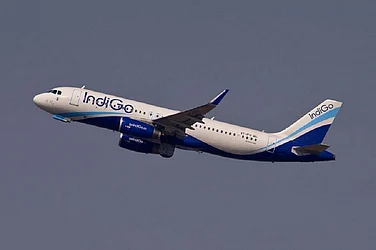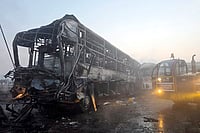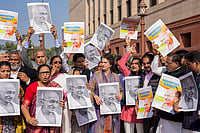Shangri La was a modern myth propagated by self-serving mystics, cranks and a best-selling British writer, but one cannot blame the urge to imagine a mountain arcadia when confronted with the snowy peaks that gather around Kalpa, Reckong Peo, Nako (Lake) and Spiti in timeless, insouciant majesticity. In the Satluj valley in Himachal Pradesh’s Kinnaur district, the verdure contrasts with the intensely blue sky mottled with great sails of clouds, as the great western Himalayas recede in ragged, circular waves, from brown to grey-blue.
Presided over by the great peak of Kinnaur Kailash, this is where ancient Hinduism meets rich Buddhist tradition in the lap of a rich tribal culture. These days, it’s a forbidden land. Even as the Himachal Pradesh government lifted restrictions on inter-state mobility of tourists, Kinnaur, much like an aristocrat not given to pandering to the masses, demurred. Kinnaur Hotel Association, a representative body, has decided to suspend tourism activities till November 1—a resolve similar to that of local stakeholders at Spiti, wrapped in cold aridity, in Lahaul-Spiti district.
Almost 150 hotels, resorts and an equal number of orchard home stays and guest houses have irrevocably lost their prime summer season to a year scarred by the pandemic. No adventurer braved the scraggy terrain this year; sought after locations offering soft adventure and camping experiences lie shut. Barring peak winter, when heavy snowfall freezes life and lakes, Kinnaur has never been as deserted and abandoned. It is a bitterly cold blow to the tourism sector.
Yet, going against the grain of the gradual opening up, there are compelling reasons for keeping Kinnaur closed to tourism. With the peak season having disappeared in the maws of the virus, this is the time to batten the hatches for winter. By next month, the area will see a sharp drop in temperature; its green valleys and mountainsides will get gradual coats of snow.
“Our situation is very peculiar—culturally, climatically and geographically. We can’t allow reckless tourism in these Covid times. Most resorts, homestays and hotels are located in orchards and farm houses. If a tourist tests positive for coronavirus, everything will be shut down. This being peak apple harvest time—we use labour from other areas too—it could result in a health hazard,” Mukesh Romchari, general secretary of Kinnaur Hotel Association tells Outlook.

Look no further Overleaf, Kalpa huddles against the mountains; right, tea for two, with a vale beyond, at a resort in Sangla valley.
His fears came true last week, when a youth died of coronavirus at Leo village, which had to be sealed off, leaving fruit growers—busy in the middle of plucking, grading, packing and marketing apples—in the lurch. Kinnaur is known for producing the finest varieties of apples in Himachal. The district markets 32,000 to 40,000 apple boxes every year, which are sold at premium prices across the country. The usual harvest time is in October-November; after which it’s the turn of dry fruits like chilgoza, walnuts and almonds.
Says Mohan Prakash Negi , a leading hotelier, “Kinnaur has a limited tourist season restricted to summer. June is the peak month for Kalpa, Sangla and the rest. There’s some footfall till September –October. But these last months are a busy time for us too—farming and harvest time for cash crops like apples and dry fruits. One just can’t welcome tourists in the harvest period.”
In fact, Kinnaur natives, like Kashmiris, stock foodgrain, vegetables, even fodder for livestock, ahead of the long, deep winter confinement. Tourism, naturally, gets low priority, though most establishments are run by people from Delhi, Mumbai, or Shimla.
Sunita Serkek , a woman entrepreneur from Shimla who invested over Rs 2 crore to set up the Batseri Resort—the local village, in Sangla valley, is Batseri—feels the pinch of a ruined season. “I have a loan of Rs two crores. The resort is just three years old. We did well in 2018 and 2019. This year, expecting a significant jump, we spent a lot on marketing. Loan repayment is a major worry now, as the hoteliers’ body hasn’t permitted tourists,” she explains. Sunita gets queries from tourists all over India who are eagerly awaiting Kinnaur’s reopening. “Let’s hope Sangla bounces back to make up for some loss,” she sighs.
However, nearby Chitkul, the last village on the Indo-Tibet Border, has started receiving tourists. Located at 11,330 feet on the banks of Baspa river, the village is rated as India’s cleanest by the Centre of Atmospheric Sciences at IIT Delhi. It’s also regarded as a trekkers’ paradise.
District Tourism Officer Dr ( Major) Avaninder Kumar informs that Kinnaur welcomes between 55,000-70,000 tourists a month during May-June. Registration is mandatory for all those travelling to ‘inner-line’ areas of Pooh, Nako, Sumdo and Spiti—a number between 1,500-3,000 in May-June.
“This year, we have had zero arrivals. Since hoteliers have imposed voluntary restrictions, even after the state government allowed opening of the sector, Kinnaur is almost deserted. Some hoteliers who are not members of the association have started operations. We are taking due care that Covid protocols are strictly enforced,” he says. So far, the number of reported Covid cases in Kinnaur is 237; 33 are active cases. Five people, including an elderly woman, have lost their lives.
Yet, as tourist spots creak back to normalcy, Kinnaur stands cold and aloof. Only those travelling to Lahaul-Spiti through winding mountain roads alongside the hurtling Sutlej are allowed to drive through the district. Strangers can only cast transitory glances at Kinnaur’s breathtaking landscape.
By Ashwani Sharma in Kalpa


























